The weather will always be there, whether we’re watching the weather or not, but as we’re both self-professed geeks, watching the weather here usually involves more than simply catching the (albeit often less than accurate) forecast on the morning news.
Thus far, we’ve only had a small temperature and humidity weather monitor that’s been hanging on our kitchen wall, whose outdoor sensors have now completely failed.
Most of our detailed weather data though has come from a collective of Monterey Bay Area weather watchers via Weather Underground online.
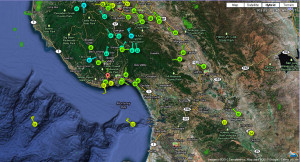
Numerous weather watchers around Monterey Bay share data from their weather stations via Weather Underground
Each dot on the map above denotes an area weather station, any of which can be selected to view detailed weather information for that location. However, tired of relying on everyone else’s weather data during significant weather events, at Christmas this sneaky elf managed to tuck a brand new weather station of our own under the holiday tree!
Although some don’t think there’s much weather in California, beyond blue skies and sunshine, we actually do have significant weather, sometimes quite a lot of it! As we’re not right at the coast, we can be subject to more weather extremes than our waterfront neighbors. Our summers can be dry and parched, or like last summer, we may be blanketed with cool, thick fog, with only an occasional chance of sunshine. Conversely, our winter weather can range from dry and frosty one year, to super-soaking wet, with a very real chance of mudslides, the next.
The Santa Cruz Mountains, due to their topography, have numerous small micro-climates. One peak or valley may experience some significant differences in temperature, humidity, or wind, than another. It rains more in some parts of the mountains, as the elevation increases, and some regions may be colder, or hotter than others, depending on where on the mountain you may be situated, or how high the surrounding tree lines are. We noticed during a cold snap last winter that while our neighbor’s gardens on the valley floor were still frozen in mid-morning, our gardens had already thawed out because of our elevation and morning sun exposure.
So now with our new weather station we’ll know exactly what the weather is doing right here at Curbstone Valley.
I know, we could just look out the window, or walk outside. Sometimes it’s painfully obvious that it’s been raining. Only the very end of this video is the actual creek, the rest is water run-off from our slopes!
However, this weather station is more for the sake of the orchard and gardens, than it is just for our idle amusement. Perhaps I should have titled this post ‘the weather geeks guide to watering a garden’?
Knowing how much precipitation we’ve had, and how windy it’s been, will help us to better use water here, both for the health of our plants, and for overall water conservation.
Here we irrigate with well water, and the property is situated over an aquifer recharge area, so it’s important to be mindful of our water usage, every day. This weather station will enable us to maximize our watering efficiency, and once the system is fully integrated, the weather station will be able to control both when, and how much we irrigate.
The weather station I selected is the Davis Vantage Pro2 system.
These systems have a reputation for durability and reliability, and each system can be customized to a variety of needs through the use of additional sensors, software, and control units. The base Vantage Pro2 system includes the anemometer to track wind speed and direction, and a barometer, temperature, and humidity sensors. However, for those of us growing food crops, the system also accommodates soil and leaf moisture sensors, and solar radiation sensors to monitor evapotranspiration.
Most importantly, this weather station can then be coupled via an irrigation control unit to communicate with most common brands of irrigation control systems. This will enable us to automatically water before a hard freeze, turn the system off if it’s raining, or turn it on if soil conditions become too dry.
At the moment, until the last of our irrigation system is installed, we are the irrigation control unit. However, our goal is that by late spring, the automatic control system will be installed. As we now have the weather station installed in the orchard area, we will select a compatible irrigation controller, so the controller, and the weather station can be in charge of our watering program, taking all of the guesswork out of watering during our drier months.
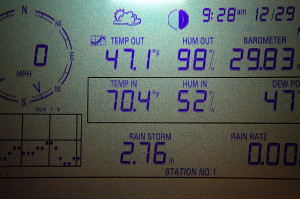
Last night's storm dumped two and three-quarter inches of rain, so obviously we won't be watering for a while!
All this leaves us with more time for planting, and that sounds like the perfect start to the New Year!
The substance of the winds is too thin for human eyes,
their written language is too difficult for human minds,
and their spoken language mostly too faint for the ears.
~John Muir

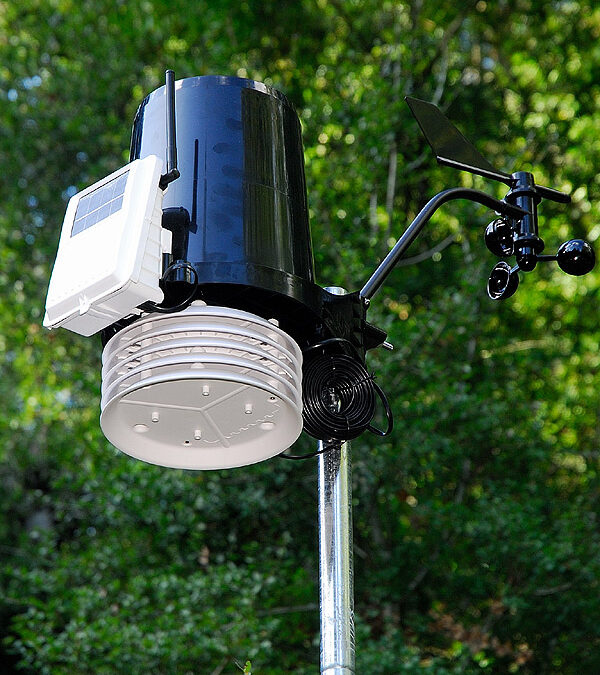

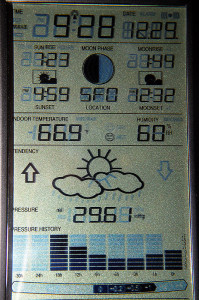
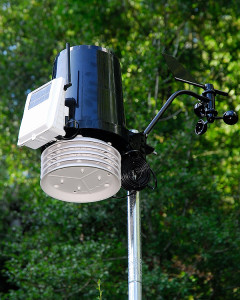

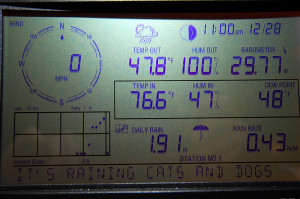







Whoa! Suddenly my goal to just have some drip irrigation with a timer seems woefully inadequate. Very cool big kid toys you have there!
Also, I love your posts so if you have any you’d be willing to submit for the next issue of How to Find Great Plants I’d be delighted (the Arbutus menziesii one, maybe?) The due date is 12/31 and I changed it around some since last time so here’s the link explaining how to enter:
http://www.appalachianfeet.com/how-to-find-great-plants/
Geeks and their toys LOL 😛 I’d be happy to share the Madrone post. I’ll see if I can get organized enough in the morning!
Your new weather station is really nice. My grower has a similar one at the office and also gets his weather via a satellite device he carries with him. But, my husband says what you said in your post. He tells me just to walk outside and look. Duh…
so I rely on WeatherBug on the computer.
I love that there are a lot of online weather stations available, but I must admit, it’s rather fun seeing the digital rain gauge fill up in your own orchard! 😉
Hi CV,
Very interesting!
I keep meaning to get myself an outdoor thermometer – although perhaps not quite as advanced 🙂
I actually liked our small wall mounted gauge we’ve had the past two and a half years (except the outdoor sensors weren’t very robust). We only went this far because this system can help us save water, but as weather is always around us, it’s easy to turn weather-watching into a hobby, even with a small system!
We just had a downpour and high winds. My rose arbor blew over but the rose seems to be ok and still in the ground. What a mess these storms have made for us. We had a small mud slide on one of our banks; covered some plants which we have sinced dug out and replanted. Hope this last storm stops before it comes down again.
Keep your head above the water!
And Have a Happy New Year!
Oh my, I hope the rose is relatively unscathed! This has been a truly sloppy weather year. We haven’t needed the ark, snorkel, or webbed feet yet, although I think we’re close. Stay dry!
Cool weather station. Meg has a weather station on top of her school hooked up to the ham radio and internet, the Hams have been working on getting it live on the internet. It call tell you the wind direction and speed and measures the rain and temps all sent to a digital display or computer.
Once we add the software for the irrigation controller, transmitting our site-specific data to the internet will be easy. We’re considering sharing our data on Weather Underground online too, but our first priority is hooking this system into the irrigation controller!
Oh, how delightfully geeky! It looks like a fun toy as well as a useful tool. I was disabused of my east coast notions about weather in California when I moved there as a new bride in March of 1969. It was a winter, like this one, of heavy rain following wildfires. I can still remember my eyes popping, as we drove up the Pacific Coast Highway from LAX to Oxnard, at the sight of houses that had slid down out of the hills and were pushed up against the side of the road! I hope your land at Curbstone Valley stays put.
We’ve had some minor mud-slips so far. Our biggest concern is we’ve had significant rainfall from October through December in 2010, and our traditional ‘wet’ months, are January through early March. Things are so saturated already that to avoid more significant mudslides, we really need a more protracted break in the soggy weather. I can’t imagine what you saw in 1969, well, actually I can, I seem to remember seeing footage from 1982 that was quite bad too, but still, in light of the recent slides in Southern California, I hope Mother Nature gives us all a break along the California coast for a while! I hate wildfires, but walls of sliding mud are no fun either!
Very impressive!
I really like your new weather station. That is a lot of water coming off of your slopes. It’s been wet here too, but not like that. I love how it says it’s “raining cats and dogs” 🙂
That was my favorite part. Clearly the developers at Davis Weather Instruments have quite the sense of humor. However, ‘raining cats and dogs’ at only a quarter inch per hour of rain-rate seems a little overblown. We had 2-inches per hour in October 2009. Would that be raining ‘buffalo and bison’? 😛
So cool to have your own weather station. I usually have to relay on the internet, and they are get it wrong so many times
amazing and impressive technology! and important to conserve water etc. over here we still use old weather lore and nature signs but it does not always work!
hope you have a wonderful new year..
mike
What a fabulous new toy – although in your case with those practical uses you’re putting it to it’s much more than a toy. I, too, know that CA has lots of weather. I have two sisters in S.F. and on one visit there was torrential rain and flooding, no sign of the famous sun. Happy New Year!
My husband enjoys weather watching and has the same kit as you have after dabbling with a Nexus setup and not being satisfied.
He sends data to Weather Underground and also to his own website and keeps a weather blog
here
Me – I just stick to the gardening side of things
I just dropped by your husband’s weather site Sue, very nice! Glad to hear he’s happy with the Vantage Pro2, so far we love it!
Ok, I was looking into the Davis instruments a while back, and now I really want one! We do have a weather station just a quarter mile from us, but it’s in a low spot and the temps there are consistently a few degrees off what they are here at the top of a hill. Of course I’d really rather have some chickens! 😉
Well, it’s a good weather station…but I’m not sure it can control chickens 😛
You mention Jan-March: I had thought I’d heard Dec & Jan were always the heaviest rains. Is it a bit different where you are? Hope the season progresses without serious problems.
Warmest wishes for a happy, healthy, golden 2011!
I truly enjoy our connection,
Alice
That was more an anecdotal statement, after spending too many February months pacing river banks here! Our house flooded after a deluge in early February one year (23 inches of rain that month alone), so I think I’m a little scarred from that! 😉 Looking at the last 15 years of raw weather data from a local station though, Dec-March is definitely our wettest period, with February the wettest month in the rain year. However, that said, I’m not adjusting for outlying data due to events such as El Niño. Adjusting for that Dec-Jan probably is the soggiest. Regardless, the hillsides are close to saturated here, and we still have 2-3 months of significant rainfall to come this season!
Cool! I need one of those! I was eyeing a remote thermometer like the one you showed at Walmart the other day and was very tempted to buy it. I really thought it would be an upgrade to the old-fashioned thermometers I am currently using. Now that I’ve seen the “Weather Station,” though, I know it will never do. And it comes with personality too! Love that “raining cats and dogs”! LOL.
Fabulous new toy and I imagine you’ll be looking at it with pleasure all winter. I’ve always wanted to learn what a barameter can tell you about the weather.
Right now we just watch the clouds come through the valley. Check out my last post and you can see that we’ve unknowingly used the wheelbarrow for a raingauge.
Happy New Year!!!
Sue
I want one! We also have wildly different (generally hotter) weather than any local forecast, and I love the idea of tying irrigation to the weather system – way cool!
We have heard about the horrible storms and mudslides in California. I hope you are not affected by this!
Your new weather station sounds like a fine tool to me, but I’m afraid I am one to poke my head out the door, or else ask my husband what the weather is doing. You do remind me of my youngest son. He somehow inherited Geek genes from somewhere, and he can always justify why he needs a particular gadget. (I admit, once I figure out how to use them, I tend to like gadgets, too!)
May you have beautiful weather and great gardening in the new year!
Clare, I think both you and I are on the same page. We also have a weather monitor that looks strikingly similar to yours, but the wind gauge component of it seems to have petered out after our last bout with 50+mph winds. As you’ve noted, the microclimates from valley floors to higher elevations can be wide-ranging. We’re at around 2,000 ft. and have noticed that our neighbors, about a 5 minute drive downhill, are typically more frost-prone than we are. Nevertheless, we’ve been hit with some icy weather this past weekend (lows in the high 20s) and are keeping a close eye on the citrus and avocados. Btw, that new weather station of yours looks intriguing. Must tell hubby about it ’cause we’re in need of an upgrade!
Camissonia, if your system is also a Davis Instruments station, you can probably just replace the anemometer. That’s one of the reasons we chose this system, in that the component parts don’t change a lot over the years for a specified system, so they’re easy to replace if something fails. Of course, it’s always fun to get a system that’s bigger and better than one you have! 😉
LOL Clare – I’ve never blogged about this before but I’m married to a weather geek – and guess what we have in our back garden…….. yip a Davis Vantage pro 2! only yours looks alot cleaner and whiter than ours does. It kinda resembles a dalek on a 6 foot metal pole doesn’t it.
We’ve got ours placing the readings on the internet and many locals check the local weather from the link. I used to have a link to that page on my blog until I discovered if you got to the map it would lead you directly to our garden so for security reasons that link came off really quick!
I was speaking to someone a few weeks ago that was telling me that I should bookmark a local weather site – he then was amazed when I told him the the readings were from my back garden.
Ha! I had no idea you were a fellow Pro2 geek 🙂 Well, if this system survives a Scottish winter, I have no worries about it putting up with our weather! You’re right, it does resemble a dalek, I thought that the first time I saw it!